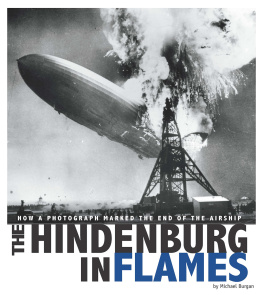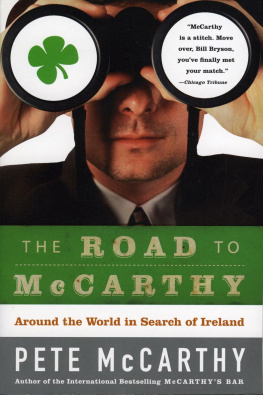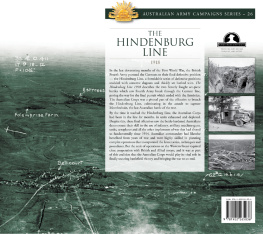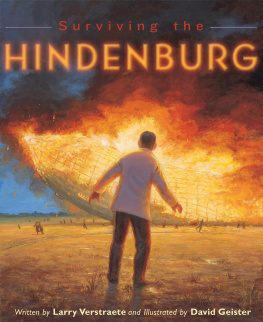McCarthy - The Hidden Hindenburg
Here you can read online McCarthy - The Hidden Hindenburg full text of the book (entire story) in english for free. Download pdf and epub, get meaning, cover and reviews about this ebook. year: 2020, publisher: Lyons Press, genre: Non-fiction. Description of the work, (preface) as well as reviews are available. Best literature library LitArk.com created for fans of good reading and offers a wide selection of genres:
Romance novel
Science fiction
Adventure
Detective
Science
History
Home and family
Prose
Art
Politics
Computer
Non-fiction
Religion
Business
Children
Humor
Choose a favorite category and find really read worthwhile books. Enjoy immersion in the world of imagination, feel the emotions of the characters or learn something new for yourself, make an fascinating discovery.

- Book:The Hidden Hindenburg
- Author:
- Publisher:Lyons Press
- Genre:
- Year:2020
- Rating:5 / 5
- Favourites:Add to favourites
- Your mark:
- 100
- 1
- 2
- 3
- 4
- 5
The Hidden Hindenburg: summary, description and annotation
We offer to read an annotation, description, summary or preface (depends on what the author of the book "The Hidden Hindenburg" wrote himself). If you haven't found the necessary information about the book — write in the comments, we will try to find it.
The Hidden Hindenburg — read online for free the complete book (whole text) full work
Below is the text of the book, divided by pages. System saving the place of the last page read, allows you to conveniently read the book "The Hidden Hindenburg" online for free, without having to search again every time where you left off. Put a bookmark, and you can go to the page where you finished reading at any time.
Font size:
Interval:
Bookmark:
T HE IRON AGONY IN THAT VOICE .
This book began a decade ago, when I taught journalism history at a college in Chicago. I told all my students that they simply had to hear the stunning and dramatic radio report of the Hindenburg disaster. Were back in May of 1937, I told them. A muddy landing field in New Jersey. A rain-soaked young announcer with slicked-back hair begins narrating. Herb Morrison is describing the giant Zeppelins uneventful arrival. Suddenly, the heat and the glow of the Hindenburg afire erupts over him. Overcome, he begins hyperventilating into his microphone . Itsburst into flamesIts a terrific crash, ladies and gentlemen The smoke and the flames now Oh, the humanity!
Semester after semester, I played the staticky recording in class. We all listened together. It was a remarkable record, I told them: one of the most vivid, raw, human reactions ever to seeing a tragedy unfold before ones eyes. One witness simply saw, spoke. His delivery was impulsive, true, a childs.
Back then, I took a cursory look into the Hindenburg tragedy to try to explain to students what happened. To my surprise, the official federal government investigation never came up with a conclusion. It ruled that an atmospheric electrical charge ignited highly flammable hydrogen gas that was leaking from the famed shipsomehow. Why there was a leak was anyones guess.
Then, a few years ago, I began wondering about the Hindenburg again. I think listening repeatedly to Morrisons newscast over the years haunted me. Somehow hearing the recording over and over made me wonder if there were something more to the story. That voice seemed to travel through the decades, to me, and ask the question: What happened?
I dove into that old, cold case. Two years of research followed. And then, when I arrived in Germany to wrap up the work in 2017, the entire story exploded. I discovered that previous books about the infamous Hindenburg were riddled with myth, with facts and episodes purposely twisted by a German legend, a world-renowned aviation pioneer desperate to conceal his war secrets. It all boils down to a fabulously successful lie.
Hugo Eckener, a goateed aviator and father of the Hindenburg, was as famous in his day as the world-renowned American pilot Charles Lindbergh. In the Roaring Twenties, the German impresario with pouchy eyes flew one of his cigar-shaped Zeppelins around the globe, met with U.S. presidents Coolidge and Hoover, and landed on the cover of Time magazine. Americans recognized his gravelly voice on the radio. In the early 1930s, in Germany, he was expected to run for president, a rival candidate to Hitler.
But the memoirs the early patriarch of aviation wrote after World War II, which would become the backbone of every subsequent Zeppelin account, are replete with undetected falsehoods that rewrote history and, along the way, hid the true cause of the Hindenburg disaster. No one caught on.
With never-before-published records from the National Archives, aviation libraries, and archival sources in Germany, I found evidence that the 800-foot-long Hindenburg was on a path to self-destruction back to its blueprints. Today, its hard to imagine just how large the Hindenburg actually was. Eight Goodyear blimps could have easily fit inside of it. Driven to beat the Americans to the largest, most luxurious aircraft everwith staterooms, a promenade deck, and a tinkling piano on boardthe German Zeppelin men had inadvertently created something that proved, over time, too big to fly.
In the winter of 1936, they belatedly discovered that their trusty techniques had somehow failed, leaving the massive Hindenburg, nearly three football fields long, dangerously vibrating. Under pressure to start the 1937 flight season, they tried hasty repairs. The Zeppelin men were flying a highly visible ornament of Nazi pride and propaganda, and suddenly in a dire race to keep it from rattling apart in the skies.
From start to finish, the Hindenburg was so intricately tied up with the Nazis, Eckener would need a contorted account to unravel it all. His revisionist memoir worked. Eckener portrayed himself as Day, when in fact he was Night.
Minor discrepancies in Eckeners accounts put me on the long trail of his deception. The more stones I turned, the more muck I found. It all added up to something remarkable: Hugo Eckener, a global celebrity in between the world wars, had led a double life. His fanatical desire to build the largest aircraft ever, the Hindenburg, first connected him with chilling figures including Joseph Goebbels and Hermann Gring. Then, step by step, behind the scenes, Eckener skulked along a crooked road to spy flights, to rocket bombs, to slave labor from the notorious Dachau concentration camp.
Unlike Nazi allies who slipped into Argentina or elsewhere after the war, Hugo Eckener hid in plain sight. He used his prewar fame to hoodwink the public, brazenly taking the spotlight to declare himself a hero, who, given his self-proclaimed vocal opposition to the Hitler regime, supposedly came within a hair of losing his life in Nazi Germany.
The Eckener pretense began to crack in German scholarship on World War II arms production and slave labor after the mid-1980s, with the opening of archives on judicial procedures aimed at identifying and purging Nazis from public life. Eckeners name surfaced. I paired that research with other, primary sources: corporate memos and reports in Germany, the Hindenburg investigative files at the National Archives in Washington, personal letters, and declassified U.S. Army documents.
I discovered that the Hindenburg itself was the reason Eckener emerged as an early and vocal Hitler supporter, and his allegiance only darkened through the war. When Germany lost, he shifted to denial. To escape any wartime suspicions, he would slickly alter Hindenburg history to fabricate an anti-Nazi record. In the end, he used the Hindenburg as his getaway vehicle.
There is imposing evidence on the Hindenburgs demise. A month after the disaster, a whistleblowers revelatory letter to investigators, alone, could have blown the case wide open way back in 1937. Instead, a U.S. Navy officer nicknamed Rosie stepped in to cover it up. With that and other crucial evidence buried for decades, sensational sabotage theories bubbled up. But the only thing actually sabotaged was the truth.
I have been a professional writer for more than three decades, twenty-two years as a reporter and editor at the Wall Street Journal. I have never encountered a single story with such scheming, duplicity, and lies. Well be talking about more than just an old flying machine. Well be talking about facts and lies, about truth and fiction, and the cost of failing to distinguish between them.
So much has been wrong for so long, the facts so twisted beyond recognition, that we simply have to go back and start over. This isnt merely a revision. This, finally, is what really happened, the story of the hidden Hindenburg.
MM
F IVE YEARS AGO , I STEPPED ONTO A Z EPPELIN AND LANDED IN A G ER man concentration camp.
It was an entirely unexpected destination, and I encountered several surprising people along the way. One of the notables: Mark Heald, an eyewitness to the Hindenburg disaster as an eight-year-old boy in New Jersey. In his nineties now, he is a retired physics professor, and he kindly let me record his recollections for my podcast, the Hidden Hindenburg, which details my quest to solve this mysterious tragedy. He may well be its last living witness.
The story behind the Hindenburg disaster was embedded in numerous German texts: telegrams, Nazi memos, personal letters, technical documents, even poems. Kathy DiCenzo and her colleagues at KD Translations thoughtfully rendered thousands of words for me into English, some from paragraphs originally in a dense, old German font called Fraktur, some scrawled in jagged handwriting.
Font size:
Interval:
Bookmark:
Similar books «The Hidden Hindenburg»
Look at similar books to The Hidden Hindenburg. We have selected literature similar in name and meaning in the hope of providing readers with more options to find new, interesting, not yet read works.
Discussion, reviews of the book The Hidden Hindenburg and just readers' own opinions. Leave your comments, write what you think about the work, its meaning or the main characters. Specify what exactly you liked and what you didn't like, and why you think so.















